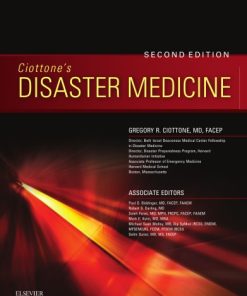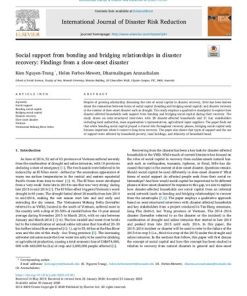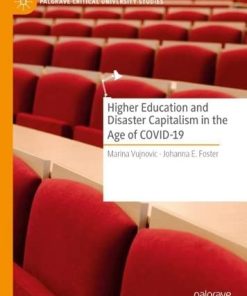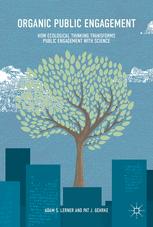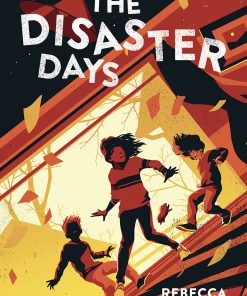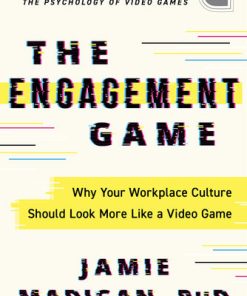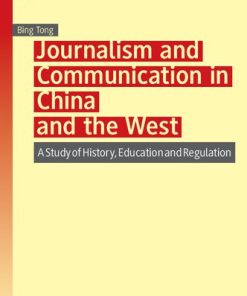Disaster education, communication and engagement 1st edition by Neil Dufty 1119569770 9781119569770
$50.00 Original price was: $50.00.$25.00Current price is: $25.00.
Disaster education, communication and engagement 1st edition by Neil Dufty – Ebook PDF Instant Download/DeliveryISBN: 1119569770, 9781119569770
Full download Disaster education, communication and engagement 1st edition after payment.
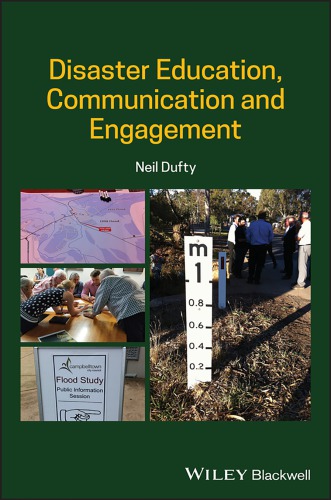
Product details:
ISBN-10 : 1119569770
ISBN-13 : 9781119569770
Author : Neil Dufty
A detailed guide to the design and evaluation of effective disaster learning programs Disaster Education, Communication and Engagement provides a much-needed evidence-based guide for designing effective disaster learning plans and programs that are tailored to local communities and their particular hazard risks. Drawing on the most recent research from disaster psychology, disaster sociology, and education psychology, as well as evaluations of disaster learning programs, the book contains practical guidance for putting in place a proven design framework. The book outlines the steps to take in order to tailor a disaster education, communication and engagement program and highlights illustrative examples of effective programs and activities from around the world. The author includes information on how to identify potential community learners and presents a methodology for understanding the at-risk community, its hazard risks, disaster risk reduction, and emergency management arrangements. Disaster Education, Communication and Engagement describes both country-wide campaigns and local disaster programs that involve community participation. This important resource: Presents a detailed framework to guide the design and evaluation of tailored disaster learning programs Includes information that links disaster resilience with sustainability and climate change learning Describes the ‘disaster cycle’ and reviews learning content and methods related to the cycle Explains effective ways to combine disaster education, disaster communications, and disaster-related engagement Contains material on using new technologies such as gamification, virtual reality, and social media Written for emergency managers, students of emergency management, and humanitarian courses, Disaster Education, Communication and Engagement is a hands-on guide filled with ideas and templates for designing and evaluating targeted disaster learning programs.
Disaster education, communication and engagement 1st Table of contents:
Part I Context
Chapter 1 Disasters and Learning
1.1 Hazard
1.2 Disaster
1.3 Disasters Are Socially Constructed
1.4 Disasters and Communities
1.5 Learning
References
Chapter 2 Disaster ECE
2.1 Disaster Education
2.1.1 Defining Disaster Education
2.1.2 Modes of Disaster Education
2.1.3 Learning Relationships
2.2 Disaster Communication
2.2.1 Risk Communication
2.2.1.1 Risk
2.2.1.2 Risk Perception
2.2.1.3 Trust
2.2.1.4 Communicating Risk
2.2.2 Crisis Communication
2.2.2.1 Early Warning
2.2.2.2 Response
2.2.2.3 Recovery
2.2.2.4 Between Agencies
2.3 Engagement
2.3.1 Public Participation Spectrum
2.3.2 Crowdsourcing
2.3.3 Citizen Science
2.3.4 Community Participatory Disaster Risk Assessment
2.3.5 Volunteered Geographic Information
2.4 Disaster ECE
References
Chapter 3 ECE Across the Disaster Management Cycle
3.1 ‘The Disaster Management Cycle’
3.2 Mitigation
3.2.1 Disaster Risk Analysis
3.2.2 Risk Awareness
3.2.3 Mitigation Options
3.3 Preparedness
3.3.1 Preparedness Guides
3.3.2 Emergency Plans
3.3.3 Campaigns
3.3.4 Learning Methods
3.4 Early Warning
3.5 Response
3.5.1 News Media
3.5.2 Social Media
3.6 Recovery
3.7 Lessons Learned
3.8 Reconstruction
References
Chapter 4 The Importance and Usefulness of Disaster ECE
4.1 Inputs
4.2 Activities
4.3 Outputs
4.4 Short-Term Impacts
4.5 Intermediate Impacts
4.6 Outcomes
References
Chapter 5 Exploring Relevant Research Fields
5.1 Disaster Resilience
5.1.1 The Resilience Concept
5.1.2 Disaster ECE and Resilience
5.2 Disaster Psychology
5.2.1 Risk Awareness and Perception
5.2.2 Previous Experience and Local Knowledge
5.2.3 Preparedness
5.2.3.1 The Protection Motivation Theory (PMT)
5.2.3.2 Protective Action Decision Model (PADM)
5.2.3.3 Socio-Cognitive Preparedness Model
5.2.4 Response
5.2.5 Recovery
5.3 Disaster Sociology
5.3.1 Vulnerability
5.3.2 Social Capital
5.4 Learning Theory
5.4.1 Behavioural Learning
5.4.2 Cognitive Learning
5.4.3 Affective Learning
5.4.4 Social Learning
References
Part II Local Disaster ECE
Chapter 6 Designing Effective Disaster ECE Plans and Programmes
6.1 Lifelong Learning
6.2 Localisation and Learner Needs
6.3 A Framework for Tailoring Disaster ECE
6.3.1 Principles of Effective Disaster Education
6.3.2 ‘Palettes’ of Potential Content and Methods
6.3.3 ‘Filters’ to Choose Appropriate Local Disaster ECE Content and Methods
References
Chapter 7 Disaster ECE Principles
References
Chapter 8 Disaster ECE Content
8.1 Across the Disaster Management Cycle
8.1.1 Mitigation
8.1.2 Preparedness
8.1.3 Early Warning
8.1.4 Response
8.1.5 Recovery
8.1.6 Lessons Learned
8.1.7 Reconstruction
8.2 Disaster Resilience
8.3 Climate Change
8.3.1 Climate Change and Disaster Risk Reduction
8.3.2 ‘Global Warming’ vs ‘Climate Change’
8.3.3 Support for Climate Change
8.3.4 Implications for Disaster ECE
8.4 Sustainability
References
Chapter 9 Disaster ECE Methods
9.1 A Typology of Disaster ECE Methods
9.2 Information
9.2.1 Maps
9.2.2 Frequently Asked Questions (FAQs)
9.2.3 Warning Sirens
9.2.4 Emergency Alert Messages
9.3 Interactions
9.3.1 Social Media
9.3.2 Apps
9.3.3 Games
9.3.4 Virtual Reality
9.3.5 Scenario Planning
9.3.6 People–People Interactions
9.4 Skills and Capabilities
9.4.1 Drills
9.4.2 Exercises
9.4.3 Oral, Visual, and Written Histories
9.4.4 Communities of Practice
9.4.5 Awards
9.4.6 Simulations
9.4.7 Staff Ride
9.4.8 Volunteering
9.5 Creative Expression
9.5.1 Art
9.5.2 Writing
9.5.3 Movies
9.5.4 Puppetry
9.5.5 Memorials
9.6 Integrating Methods
References
Chapter 10 Understanding Communities and Their Risks
10.1 Understanding the Local Community
10.1.1 Population Surveys
10.1.2 Questionnaires
10.1.3 Social Network Analysis
10.1.4 Local Knowledge
10.2 Local Disaster Risks
10.3 Risk Reduction Measures
10.4 Emergency Management
10.5 Building Resilience
References
Chapter 11 Learners
11.1 Youth
11.1.1 Vulnerability
11.1.2 Youth and DRR
11.1.3 Disaster ECE in Schools
11.1.4 Curriculum-Based Learning
11.1.5 Non-curricula Learning
11.2 Other Vulnerable People
11.2.1 Women and Girls
11.2.2 People with Disabilities
11.2.3 Older People
11.3 Businesses
11.3.1 Vulnerabilities
11.3.2 Mitigation
11.3.3 Preparedness
11.3.4 Recovery and Resilience
11.4 Animal Guardians
11.5 Tourists
11.6 Archetypes
References
Chapter 12 Disaster ECE Programmes and Plans
12.1 Tailoring Disaster ECE
12.2 Disaster ECE Plans
12.3 Disaster ECE Programmes
12.4 Evaluation
12.5 Participation
People also search for Disaster education, communication and engagement 1st:
what is disaster communication
effects of natural disasters on education
disaster communication examples
disaster response communication
disaster communication plan
Tags: Disaster education, communication, engagement, Neil Dufty
You may also like…
Uncategorized
Children's Books - Literature & Fiction
(Ebook PDF) The Disaster Days 1st edition by Rebecca Behrens 1492673323 9781492673323 full chapters
Politics & Philosophy - Social Sciences
Higher Education and Disaster Capitalism in the Age of COVID-19 Marina Vujnovic
Relationships & Lifestyle - Diet & Nutrition
Business & Economics
Reference - Writing




